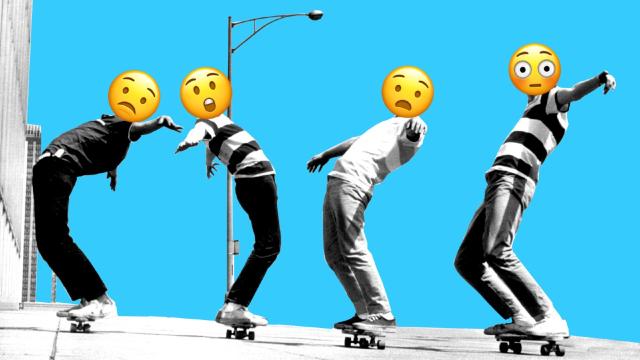Skateboarding has never followed a rulebook, which means that on some level, a piece about learning how to skate probably defies its countercultural roots. And though it’s fostered the growth of a global community, skating is a solitary sport, which is probably why it’s become a newfound pastime for adults during the pandemic.
As someone who grew up skating, I’ve been amused by a few recent stories written by guys who’ve taken their first trips to the skatepark in their 30s as a means of escaping pandemic-stricken solitude. Watching adults learn how to kick turn, ollie, and drop in on ramps is a funny lens into society’s collective restlessness during COVID, but I salute anyone who’s hopped on a board because they correctly thought skateboarding would be an adventurous outlet.
Here’s how you might go about learning to skate as an adult. Just don’t be surprised when you head to the skatepark and are surrounded by kids who shred infinitely harder than we ever will.
Buy an actual board
A complete skateboard consists of multiple parts: A grip-taped skate deck, trucks, wheels, bearings, and maybe risers to pad the impact of your metal trucks hitting the board. There’s also eight bolts and lock nuts to attach your trucks to you wooden deck.
Don’t skimp on buying a real board — you really don’t want something from Target (or another big box retailer) made from crappy wood, with trucks made from weak metal. Unlike with learning how to play drums or another instrument, you’re not looking for lower-end equipment when you start out, because the cheap stuff can make it easier for you to hurt yourself.
I’d recommend heading to your local skate shop and asking whoever works there what you should get. But in reality, as long as you’re buying a board and accessories from legit manufacturers, you’re in good shape. There’s a lot of great — even iconic — legacy companies to choose from when you’re buying your board: Flip, Baker, Element, Girl, Toy Machine, and Enjoi (among so many others) are all great options.
It’s the same deal when it comes to trucks and wheels. Companies like Independent, Venture, and Tensor (among others) are good options for trucks, while wheels made by Spitfire, Pig, Bones, and many other companies should get you rolling. You’ll find some crossover when it comes to companies that make skateboards as well as other products — sometimes companies that make boards also make wheels, but usually companies that make trucks focus solely on that.
The overall point I’m trying to make is to trust the name brands. Companies that make legit boards and products will almost always sponsor professional skaters, make skate videos, and produce their own apparel. You can tell a real skateboard apart from an imitation pretty quickly once you’ve familiarized yourself with authentic skate products.
Find an easy place to skate, then move on from there
Don’t expect to careen down the hills like an animal just yet (but if you’d like to glean inspiration from someone who does exactly that, look no further). What you should do is find a nice, forgiving environment to collect your first bruises. I was lucky that I grew up on a cul-de-sac that allowed me to roam around without fear of getting flattened by a car, but you probably don’t have that luxury.
Find an open tennis or basketball court to learn how to push, kick-turn, and ollie. You need a smooth surface that will be easy to push around on. Familiarise yourself with the feel of the board beneath your feet and trust your instincts when it comes to learning new tricks. Once you’ve gotten a bit more comfortable and can trust your balance, you’ll probably start to develop your own taste in tricks and obstacles.
The writer Steve Rousseau, who got started in skateboarding during the pandemic, recommends setting low expectations and forgiving yourself for the steep learning curve that comes with the sport.
“Just go at your own pace,” he says. “Celebrate whenever you learn something new, no matter how minor or unimpressive you might think it is compared to ‘real’ skateboarders.”
Get inspired
So much of the sport’s creative impetus comes from feeding off of the energy of other skaters. Skate videos present a vast canon of styles to identify with, and also present great history lessons in the sport’s evolution. When it comes to gleaning inspiration, Rousseau puts it this way:
Just watch a lot of skate videos! There are so many different styles and vibes and ways to skate — find one that resonates with you. Don’t look at skating as like a progression of tricks you want to learn, but more like a style you want to emulate.
With all of this said, there really is no “right” way to learn how to stake. Just understand that you’ll fall often, but that’s part of the process, even for the most seasoned skaters. The bottom line is, if you’ve got a board, put it on the pavement, and go from there.

Leave a Reply
You must be logged in to post a comment.